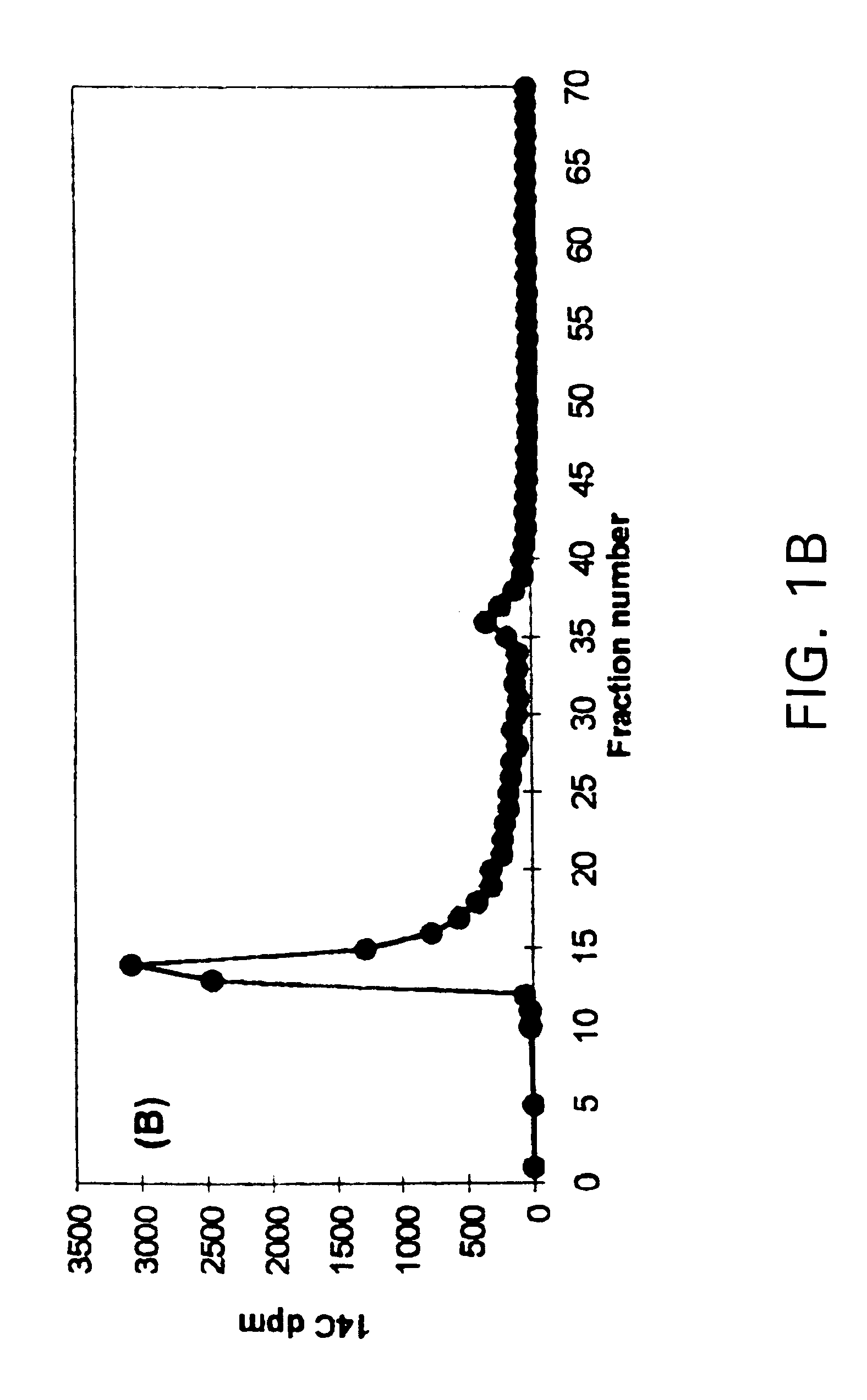Chemical method for lignin depolymerization
a lignin depolymerization and lignin technology, applied in the field of lignin depolymerization, can solve the problems of yellowing and accelerating aging of paper, and reducing the strength of paper due to less specific chemical reactions, so as to accelerate the depolymerization and preserve the fibre strength of cellulose. , the effect of reducing costs
- Summary
- Abstract
- Description
- Claims
- Application Information
AI Technical Summary
Benefits of technology
Problems solved by technology
Method used
Image
Examples
example 1
Lignin degradation in general: depolymerization of synthetic .sup.14 C-labeled lignin (DHP) with copper, pyridine and hydrogen peroxide.
Synthetic .sup.14 C-labeled lignin (5 .mu.l, 14500 dpm) was pipetted into a small glass vial. 10 .mu.l Pyridine, 50 .mu.l CuSO.sub.4 (10 mM), and 35 ml water were added and stirred for 30 min. At the start of the reaction and after 30, 60, 90 and 120 minutes 20 .mu.l of H.sub.2 O.sub.2 (1 M) were added to the reaction mixture and stirred at room temperature for 150 minutes. After the reaction, the lignin was sized by preparative gel permeation chromatography (GPC) on a 1.5.times.42 cm column of Sephadex LH20 (Pharmacia LKB Biotechnology Inc.) in DMF with 0.08M LiCl.
Results: (FIG. 1)
The synthetic lignin was depolymerized by the H.sub.2 O.sub.2 / Cu(II) / pyridine system. Degradation compounds smaller than monomeric lignin model compounds (veratraldehyde) were formed by this system.
example 2
Lignin degradation in general: depolymerization of synthetic .sup.14 C-labeled lignin (DHP) with copper, pyridine and organic peroxide (tert-butyl hydroperoxide).
Synthetic .sup.14 C-labeled lignin (5 .mu.l, 14500 dpm) was pipetted into a small glass vial. 10 .mu.l Pyridine, 50 .mu.l CuSO.sub.4 (10 mM), and 115 .mu.l water were added and stirred for 30 min. At the start of the reaction, 20 .mu.l of a 0.8% aqueous cumene hydroperoxide solution was added to the reaction mixture and stirred at room temperature for 72 hr. After the reaction, the lignin was sized by preparative gel permeation chromatography (GPC) on a 1.5.times.42 cm column of Sephadex LH20 (Pharmacia LKB Biotechnology Inc.) in DMF with 0.08M LiCl.
10 .mu.l water were added instead of pyridine in the control.
Results: (FIG. 2)
The synthetic lignin was intensively depolymerized by the cumene hydroperoxide / Cu(II) / pyridine system. It is evident from FIG. 2 that the addition of pyridine greatly enhanced the depolymerization rate...
example 3
Bleaching of oxygen delignified kraft pulp (OKP) by using copper and coordination compound plus organic peroxide as an additional step to alkaline hydrogen peroxide bleaching (Cu--E--Q--P--P--P).
100 g wet weight (contains 20 g dry weight) of oxygen delignified kraft pulp are added to:
Cu-stage: 100 ml water, 10 ml copper sulfate (10 mM), 0.5 ml organic peroxide (CHP), 1 ml solution of copper coordination compound.sup.1). The pulp suspension is mixed and incubated at 80.degree. C. for 240 minutes. The pulp is washed twice with water. E-stage: 10% consistency, 10% NaOH on pulp, 60.degree. C. for 1 hour. Q-stage: The pulp is washed with a solution containing a Na-salt of EDTA (0.5% on pulp DW) at pH 5 for 1 hour at 90.degree. C. at 10% consistency. P-stage: After thorough washing pulp bleaching was carried out at 10% consistency at 90.degree. C. in one or three stages using 2.5, 2.0, 1.5% H.sub.2 O.sub.2 and 2.5, 2.0, 1.0% NaOH on pulp, respectively, in each stage. The bleaching time wa...
PUM
| Property | Measurement | Unit |
|---|---|---|
| temperature | aaaaa | aaaaa |
| incubation time | aaaaa | aaaaa |
| temperatures | aaaaa | aaaaa |
Abstract
Description
Claims
Application Information
 Login to View More
Login to View More - R&D
- Intellectual Property
- Life Sciences
- Materials
- Tech Scout
- Unparalleled Data Quality
- Higher Quality Content
- 60% Fewer Hallucinations
Browse by: Latest US Patents, China's latest patents, Technical Efficacy Thesaurus, Application Domain, Technology Topic, Popular Technical Reports.
© 2025 PatSnap. All rights reserved.Legal|Privacy policy|Modern Slavery Act Transparency Statement|Sitemap|About US| Contact US: help@patsnap.com



